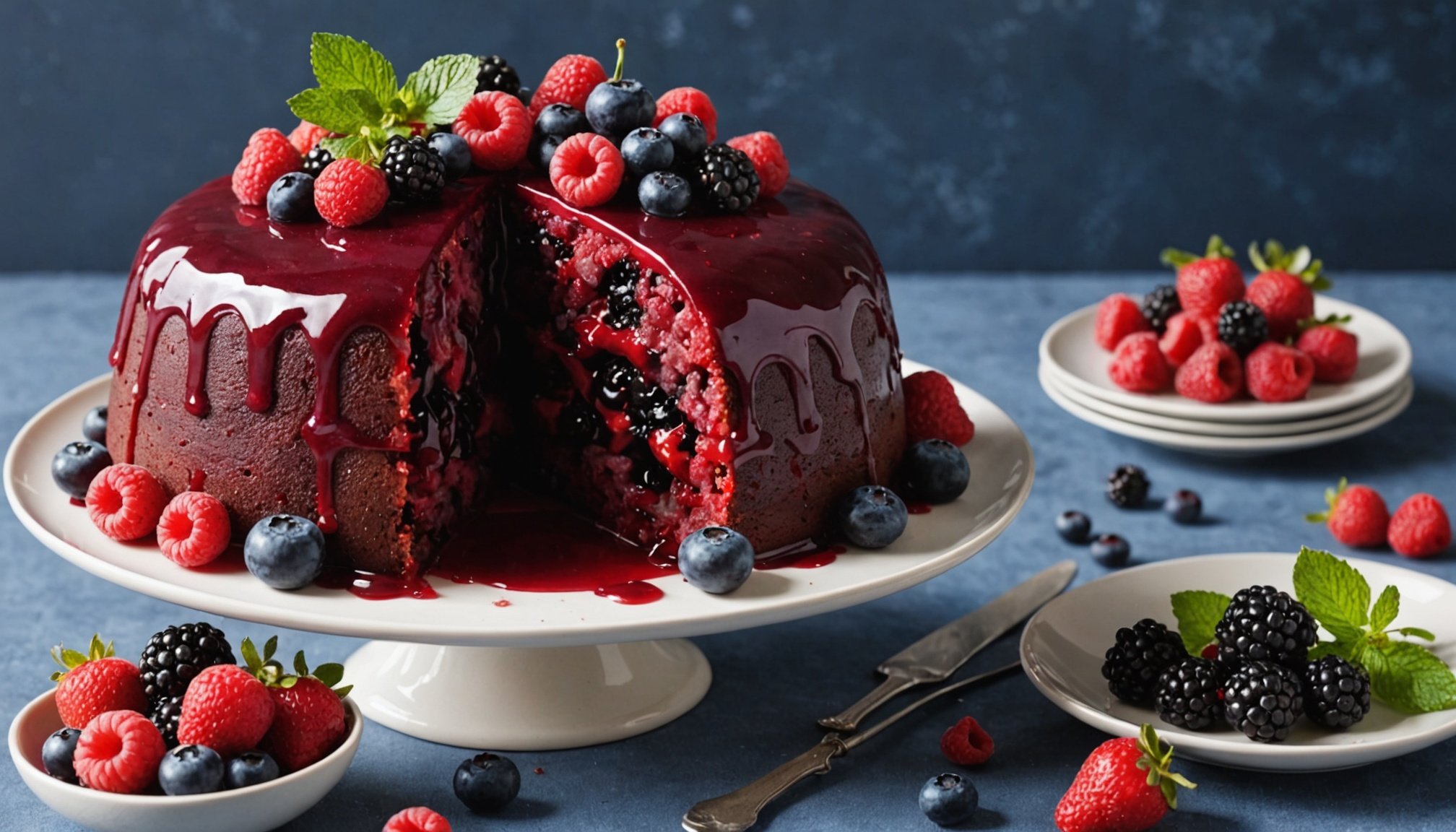Understanding English Summer Pudding
English summer pudding is a classic British dessert renowned for its simplicity and vibrant flavours. Originating in the late 19th century, this dessert is a festival of fresh berries encased in a bread shell. Its roots are traced back to the need for a lighter dessert in contrast to the heavy, cream-laden dessert history of English cuisine. Traditionally, it was a delightful way to enjoy the summer’s berry harvest with minimal fuss.
One of the cultural significance elements of English summer pudding is its association with British summertime celebrations, such as garden parties and family gatherings. This dessert was not only a refreshing conclusion to meals but also a showpiece of the finest seasonal produce. Over time, its humble beginnings have evolved, reflecting the cultural shifts within UK food preferences.
Also read : Crafting the Perfect Crust for Genuine English Cottage Pie: Expert Tips and Techniques
The dessert has seen numerous evolution of the recipe variations. While the classic recipe focuses on red and black currants, contemporary variations have embraced a broader range of berries. Regional variations have introduced ingredients like elderflowers or apples, showcasing local cultural significance. Despite its few ingredients, English summer pudding continues to intrigue with its balance of dessert history and modern innovation.
Ingredients for the Perfect Summer Pudding
Creating a quintessential summer pudding begins with selecting the right ingredients. The defining components are fresh berries, providing both the vibrant colour and flavor essential for this dish. Typically, raspberries, red currants, and black currants are preferred for their tartness, balancing the bread’s texture. Each berry contributes different levels of sweetness and acidity, crucial for achieving the desired harmony of flavours.
In parallel : Unlock Culinary Excellence: Shaping Tomorrow’s Food Industry Today
The recipe essentials also include day-old white bread, used for its ability to absorb the berry juices without becoming overly soggy. This bread forms the pudding’s frame, encasing the mixture of berries, and is selected for its neutral taste, allowing the berry flavours to shine.
For those looking to customise, consider introducing optional ingredients like elderflowers or a hint of citrus zest for complexity. These variations can create a unique twist while preserving the dish’s spirit. Softened fruits, like apples or pears, can also be added for different textures. Understanding these summer pudding ingredients—both traditional and optional—lays the foundation for crafting this timeless dessert, inviting creativity while celebrating its classic essence.
Step-by-Step Preparation Guide
Creating an English summer pudding is a rewarding process that requires attention to detail. Follow these steps for the perfect result:
Preparing the Berries
Start by washing the fresh berries gently to preserve their delicate nature. Use cold water and a colander to ensure thorough cleaning without damaging the berries. To maintain their vibrant colour and flavour, pat the berries dry with a paper towel. This step ensures the berries retain their juices during the pudding assembly. When balancing sweetness and acidity, it’s crucial to taste your berry mix and add a touch of sugar if necessary.
Assembling the Pudding
The foundation of the pudding is crucial for even flavor distribution. Begin by layering the bread slices in a medium glass bowl, overlapping them slightly to prevent gaps. For the best texture, select a day-old white bread as it absorbs berry juices effectively. Once the berries are added, place a final bread layer to seal the top. Applying gentle pressure and using a weight, like a plate, helps compact the pudding and enhance the texture.
Chilling and Serving
Chill the pudding in the fridge for at least four hours, preferably overnight, to allow the flavors to meld and the bread to become fully saturated with juices. Before serving, turn the pudding onto a plate, and garnish with fresh berries or mint leaves for aesthetic appeal.
Tips for Achieving the Ideal Texture and Flavor
When crafting an English summer pudding, mastering the texture and flavor is essential. Adjusting the sweetness level to suit personal preferences is a critical first step. Taste your berry mixture and add sugar gradually until the desired balance is achieved. This ensures the tartness of fresh berries isn’t overshadowed, maintaining the characteristic vibrant flavors.
Enhancing the richness of flavors can be done by incorporating simple techniques such as marinating the berries briefly with a splash of elderflower cordial. The cordial infuses additional layers of aroma, complementing the berries beautifully without altering the dessert’s traditional essence.
Avoid common mistakes like using overly moist bread, which results in a soggy pudding. To remedy this, opt for day-old bread as it provides the right absorption rate, forming a sturdy frame. Another frequent pitfall is insufficient chilling time. Ensuring the pudding sits in the refrigerator overnight allows the bread to soak up all the berry juices, achieving an ideal texture.
Following these summer pudding tips will not only refine the texture but also enhance the overall flavor, creating a dessert that delights in every bite.
Variations of Summer Pudding
Summer pudding variations offer a delightful way to explore different flavour dimensions and enjoy this classic dessert year-round. While traditional recipes focus on berries like raspberries and currants, considering alternative berry combinations can elevate the taste experience. For instance, replacing red currants with blueberries can lend a sweeter, mellower flavour, while still maintaining the dessert’s signature boldness.
Exploring seasonal fruit substitutions ensures flexibility and creativity. Consider using stone fruits such as peaches or plums in late summer months for a distinctive spin. Additionally, incorporating autumnal fruits like pears can make the pudding fitting for different seasonal celebrations.
For those keen on creative twists, adding citrus zest infuses refreshing notes that contrast beautifully with the berry base. Herbs, particularly mint or basil, can add unexpected yet harmonious accents. To incorporate these elements, infuse the bread or berry mixture with a hint of their essence.
Ultimately, experimenting with summer pudding variations empowers you to personalise the dessert according to flavour profiles you favour, while respecting its traditional roots. Embrace innovative ideas while staying true to the pudding’s timeless charm.
Serving Suggestions
Embracing the delights of English summer pudding extends beyond its preparation—what truly enhances the experience is thoughtful serving. Understanding summer pudding pairings can transform this classic dessert into a memorable culinary moment.
Consider complementing summer pudding with lightly whipped cream. The cream’s subtle richness balances the tartness of the berries, enhancing the dessert’s vibrant flavours. Pairing with a dessert wine, such as a Moscato, can also be delightful; its sweetness mirrors the fresh berries, creating an elegant harmony.
Experiment with different serving styles to elevate your presentation. Individual pudding servings in ramekins add a personal touch, perfect for intimate gatherings. Alternatively, serve a large pudding at the centre of the table for a more communal experience, encouraging conviviality and shared enjoyment.
For visual appeal, garnish with mint leaves or a dusting of icing sugar. These simple yet effective presentation tips capture attention and celebrate the pudding’s natural beauty.
By mastering summer pudding pairings and experimenting with creative serving styles, you can elevate this traditional dessert, leaving a lasting impression on your guests.
Visual Resources and Additional Tips
Understanding how visual resources can complement your summer pudding preparation is invaluable. The use of cooking videos facilitates a step-by-step approach, catering especially to visual learners who benefit from seeing techniques in action. These videos provide clear demonstrations of key steps, such as layering and pressing the pudding, which are crucial for success.
To enhance your skills further, seeking recipe expertise from seasoned chefs offers a wealth of insider tips. Professionals often share nuanced advice on achieving the ideal texture and mastering flavor enhancements, ensuring your dessert is both authentic and delectable. These expert insights, whether through filmed tutorials or written articles, help demystify the processes involved in creating this classic dish.
Visual resources not only guide but also inspire creativity. Seeing how others integrate alternative berries or incorporate creative twists can ignite new ideas. Engaging with such content expands your understanding and appreciation of English summer pudding, supporting both traditional approaches and modern adaptations. By utilizing these tools, you can confidently approach preparation and elevate your dessert-making experience.











